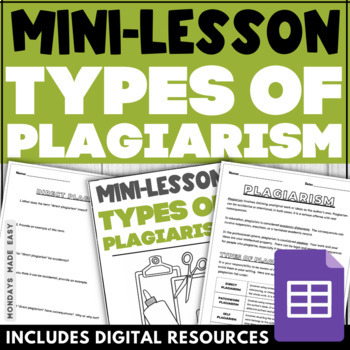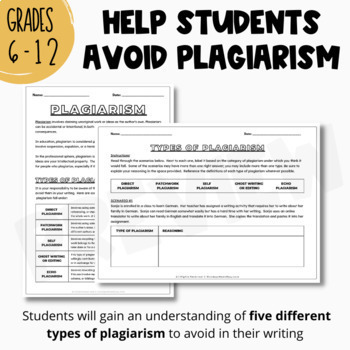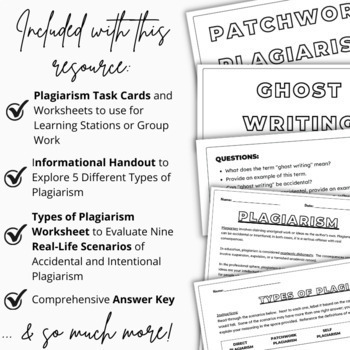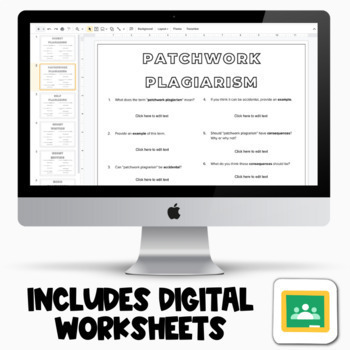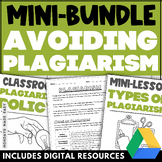Different Types of Plagiarism - Avoiding Plagiarism Lessons and Activities - AI
- Zip
- Google Apps™

What educators are saying
Also included in
- This bundle of lessons and activities will support your students in avoiding plagiarism in their writing. Explore different types of plagiarism and develop a classroom plagiarism policy using these informational handouts, worksheets, and activities! Suitable for online learning and Google ClassrooPrice $9.45Original Price $9.95Save $0.50
Description
Updated in 2023 to include examples of plagiarism involving artificial intelligence (AI)! Avoiding plagiarism begins with teaching students about the different types of plagiarism. This lesson explores five types of plagiarism and includes worksheets, handouts, task cards, and digital worksheets for Google Classroom®.
Included with this Types of Plagiarism Lesson:
✏️ Types of Plagiarism Task Cards - Print
✏️ Types of Plagiarism Worksheets for Task Card Activity - Digital & Print
✏️ Different Types of Plagiarism Informational Handout
✏️ Different Types of Plagiarism Graphic Organizer - Digital & Print
✏️ Detailed Answer Key
✏️ Teacher Instructions for using this resource
How to use these Types of Plagiarism Activities:
This lesson will help students gain an understanding of the different types of plagiarism to promote avoiding plagiarism in their writing. Explore the following types of plagiarism with your students:
- Direct Plagiarism
- Patchwork Plagiarism
- Self-Plagiarism
- Ghost Writing / Ghost Editing
- Echo Plagiarism
You can begin this mini-lesson with an inquiry-based activity using the Types of Plagiarism Plagiarism Task Cards. There are six task cards, each with a set of questions on the back. Cut these task cards out and place them at separate stations around the room. You can divide students into six groups and have each group explore a separate task card; alternatively, you can have each student rotate around the room and answer the questions on the Plagiarism Task Card Worksheets for each respective station.
After exploring the task cards independently, students can read the Different Types of Plagiarism Handout. This handout explains that plagiarism can be both accidental or intentional and that certain consequences may be implemented in both circumstances. It also discusses how plagiarism exists in both academic and professional spheres. Finally, It defines each type of plagiarism so that students have these definitions for future reference.
Students can then work on the Different Types of Plagiarism Graphic Organizer. This activity explores 13 scenarios involving plagiarism, including explicit examples of the use of artificial intelligence (AI). These scenarios are common instances of plagiarism that you've likely experienced in your classroom. Students must label the type of plagiarism and explain the reasoning behind their choice.
To consolidate this activity, a comprehensive answer key has been included.
⭒ For classrooms utilizing Google Classroom® ⭒
To access the digital version of these worksheets, simply follow the instructions within the resource to copy the files directly to your Google Drive®.
✨ Kindly note that due to copyright restrictions, this resource is not editable. This is a common practice within the TPT marketplace in order to protect the clip artists and software providers that have authorized their intellectual property for the development of this resource.
This resource is also featured in Mondays Made Easy’s Avoiding Plagiarism Bundle.
⭐ Customer Tip! ⭐
Want FREE CREDIT to go towards purchases? Make sure to offer feedback for your downloads! Follow these instructions below:
- Go to your "My Purchases" page to find a "Provide Feedback" button next to each download.
- Follow this link to offer a quick rating and leave a short comment for the product. Each time you give feedback, TPT gives you feedback credits that you use to lower the cost of your future purchases!
- Your feedback is important to me as it helps me to continually improve my products and ensure they are meeting your needs!
Follow me! Be the first to know about product launches, sales, discounts, and free giveaways:
➾ The Blog
For questions, collaborations, or other concerns:
✉ Contact me: hello@mondaysmadeeasy.com
Access my Free Resource Library!
Mondays Made Easy is committed to the continual improvement of resources to meet the current needs of teachers. This product was last updated on September 6, 2023.

